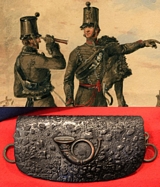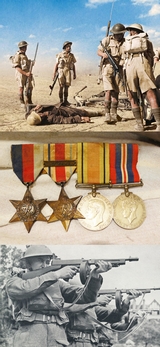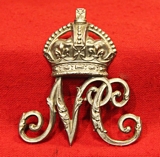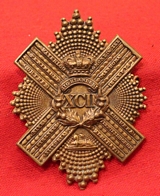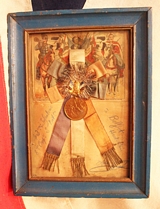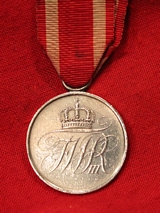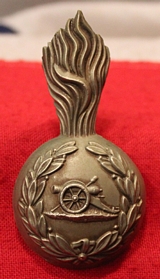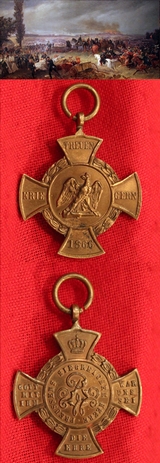Antique Arms & Militaria
Victorian Crimean War Period Light Infantry Crossbelt Pouch
Black leather foul weather pouch with coiled horn bugle for the Light Division regiments. Opens to reveal a pouch for despatches and small documents, sovereigns etc. Small leather reataining tab lacking. The Light Division was a light infantry division of the British Army. Its origins lay in "Light Companies" formed during the late 18th century, to move at speed over inhospitable terrain and protect a main force with skirmishing tactics. These units took advantage of then-new technology in the form of rifles, which allowed it to emphasise marksmanship, and were aimed primarily at disrupting and harassing enemy forces, in skirmishes before the main forces clashed.
Formed in 1803, during the Napoleonic Wars, the Light Division was raised thrice thereafter: during the Crimean War, the First World War and from 1968 to 2007. Some light infantry units remained outside the Light Division. A Light Division was again formed for service, but this was in name only as no light infantry battalions were assigned to it. The division was involved in the Battle of the Alma (20 September 1854), which is usually considered the first battle of the Crimean War, took place in the vicinity of the River Alma in the Crimea. An Anglo-French force under General St. Arnaud and Lord Raglan defeated General Menshikov's Russian army, which lost around 6,000 troops. They were also engaged in the Siege of Sevastopol (1854?1855), and the battle of Battle of Inkerman (5 November 1854) before the end of hostilities. read more
265.00 GBP
A Good Original 'Desert Rat' British WW2 British Infantry 4 Medal Group
From a former Desert Rat veteran of the 8th Army. Acquired with his helmet but sold separately. He fought Rommel's Afrika Korps, [who, under Montgomery's command, kicked the DAK's bottoms at El Alamein] and then with the 8th Army transferred to Italy in order to fight from the south right through to Rome, however, the owner of this medal group and helmet was severely wounded before he qualified for the Italy Star medal, however, he did get the Afrika Star with 8th Army bar, plus his other 3 medals. The Eighth Army was a field army formation of the British Army during the Second World War, fighting in the North African and Italian campaigns. Units came from Australia, British India, Canada, Free French Forces, Greece, New Zealand, Poland, Rhodesia, South Africa and the United Kingdom.
Significant formations which passed through the Army included V Corps, X Corps, XIII Corps, XXX Corps, I Canadian Corps and the II Polish Corps. On 26 November the Commander-in-Chief Middle East Command, General Sir Claude Auchinleck, replaced Cunningham with Major-General Neil Ritchie, following disagreements between Auchinleck and Cunningham. Despite achieving a number of tactical successes, Rommel was forced to concede Tobruk and was pushed back to El Agheila by the end of 1941. In February 1942 Rommel had regrouped his forces sufficiently to push the over-extended Eighth Army back to the Gazala line, just west of Tobruk. Both sides commenced a period of building their strength to launch new offensives but it was Rommel who took the initiative first, forcing the Eighth Army from the Gazala position.
Ritchie proved unable to halt Rommel and was replaced when Auchinleck himself took direct command of the army. The Panzer Army Afrika were eventually stopped by Auchinleck at the First Battle of El Alamein. Auchinleck, wishing to pause and regroup the Eighth Army, which had expended a lot of its strength in halting Rommel, came under intense political pressure from British Prime Minister Winston Churchill to strike back immediately. However, he proved unable to build on his success at Alamein and was replaced as Commander-in-Chief Middle-East in August 1942 by General Harold Alexander and as Eighth Army commander by Lieutenant-General William Gott. Gott was killed in an air crash on his way to take up his command and so Lieutenant-General Bernard Montgomery was appointed in his place. Alexander and Montgomery were able to resist the pressure from Churchill, building the Army's strength and adding a pursuit formation, X Corps, to the Army's XIII and XXX Corps.
At the beginning of November 1942 the Eighth Army defeated Rommel in the decisive Second Battle of El Alamein, pursuing the defeated Axis army across Libya and reaching the Mareth defensive line on the Tunisian border in February 1943, where it came under the control of 18th Army Group. The Eighth Army outflanked the Mareth defences in March 1943 and after further fighting alongside the British First Army, the other 18th Army Group component which had been campaigning in Tunisia since November 1942, the Axis forces in North Africa surrendered in May 1943 read more
175.00 GBP
French Medal Commemorating the Universal Exhibition in Paris,1855. E.Oudine
A large, original, mid 19th century French metal medal of beautiful quality made in 1855. Laureate bust of Napoleon III left. NAPOLEON III EMPEREUR (Obverse by E.A. Oudin?) Reverse: Three allegorical figures. EXPOSITION UNIVERSELLE In exergue: LA FRANCE COURONNE / L'ART ET INDUSTRIE (Reverse by A.A. Caqu?) 6.83 cm diameter. A near identical example in the Royal Collection Trust number;RCIN 444908
AA Caqu? (medallist) and E.Oudine
Napol?on III, Emperor of the French, 3rd son of Lodewyk I, King of Holland (1808-73)
Exposition Universelle (1855 : Paris) Very crisp example in nice condition, two very small edge nicks on the reverse. Exactly ten years before the opening of the first universal exposition in Paris, the future father of the event was serving a lifetime prison term in the state military fortress at Ham. Charles Louis Napol?on Bonaparte, nephew and adopted godson of the Emperor, had failed in his second attempt at a coup d'?tat against the restored monarchy of Louis Philippe. After the first attempt in 1836, the government had exiled him to America. The second attempt in 1840 earned him the detention term at Ham, behind the very walls that, over four centuries before, had held Joan of Arc captive. Many monarchists and conservatives in the Court of Peers and the National Assembly wished for terminal punishment; but the name of Napol?on was in the ascendant once again throughout France. On the very day when Charles Louis was sentenced, Emperor Napol?on's ashes were received by both royalty and the multitudes of Paris with great pomp at the church of Les Invalides. And so, rather than arouse the wrath of the still considerable number of Bonapartists, the Court of Peers determined to make the military fortress at Ham the Elba of Charles Louis. In spite of a decree banning the Bonaparte family from France forever, Charles was elected in absentia to the Assembly. He skillfully parlayed his popularity, and the halo of glory around the name Napol?on, into the presidency of the National Assembly in 1848. After a parliamentary struggle with the retreating forces ? supporters of the monarchy and revolutionaries who wished France to become a republic ? Charles Louis took command of the army and forcibly dismissed the assembly. He was proclaimed Emperor of the French on December 1, 1851. read more
195.00 GBP
Natal Carabiniers Other Ranks Helmet Plate Circa 1901-13. South Africa
Boer war period. A good die-stamped example. Crowned floreated "NC" cypher. Three loops to reverse. VGC. The Natal Carbineers participated in the invasion of Zululand in January 1879, and on 22 January, 23 members of the Regiment perished in the famous battle of Isandlwana. The unit was subsequently relegated to garrison duties at Landman?s Drift on the Mzinyathi, or Buffalo River.
South Africa, 1899?1902
Main article: Second Boer War
In September 1899, the Natal Carbineers were mobilized for active service in the British campaign to subdue the Boer republics of the Transvaal and Orange Free State. The Regiment served until October 1900, when the Natal Volunteer Forces were demobilized. Some men continued their service in the Volunteer Composite Regiment until the end of the war in May 1902.
Ladysmith, KwaZulu-Natal: From 2 November 1899 until 28 February 1900, the bulk of the Natal Carbineers was besieged in Ladysmith, and played a prominent part in that famous engagement. The most prominent military action was the attack by Colonial Forces on the Boer artillery emplacement at Gun Hill on the night of 7?8 December 1899. The Regiment lost heavily from the diseases that ravaged the garrison. A solitary squadron of the Natal Carbineers, the Estcourt-Weenen Squadron, avoided the siege of Ladysmith, and instead participated in the relief operations of Sir Redvers Buller as part of Hubert Gough's Composite Regiment. This squadron?s most notable military action of this period was the disastrous battle of Colenso on 15 December 1899, when four men were killed. These were their most serious losses for any one action during the Anglo-Boer War. Height 3 inches, width 2.75 inches read more
125.00 GBP
British Pre- 1881 XCII 92nd Gordon Highlanders Uniform Cross Belt Badge
Plate (copper lugs) Order of the Thistle Star base with each arm of the saltire bearing three of the regiment?s battle honours, "XCII" to the centre within a thistle wreath surmounted by a crown resting on a scroll inscribed ?Highlanders?, lower section of the star bearing the sphinx on a blank tablet, very crisp detail, 71.3 mm x 95 mm, intact lugs, contact marks and light wear, very fine. read more
175.00 GBP
Souvenir de la Revision Classe 1905, 42nd Infantrie 8th Co. 2nd Bn
Republic Francais framed medallion with rosette and print of cavalry. Translation; Remembrance of Class 1905 revision. 42nd Infantry Regiment (42e r?giment d?infanterie or 42e RI) was an infantry regiment of the French Army, raised in 1635 as the 'R?giment de Calvisson'. It was renamed the 1638 : 'R?giment de Montpezat' in 1638 and the 'R?giment du Limousin' in 1684, before first gaining its numeral of 42 in 1791. During the First World War it was nicknamed the 'As de Carreau', since it was part of the 'Division des As' (a nickname for 14th Infantry Division). read more
75.00 GBP
A Fine Prussian Military Honour Medal In Silver 1814.
A large silver medal on its original silk ribbon. King Fredrick William III's Ehrenzeichen (honour medal). The inscription "VERDIENST UM DEN STAAT" (Meritorious Service to the State) which appears in the centre of the medal surrounded by a circular wreath of laurel leaves remained unchanged from its inception in 1814 until 1918. To better appreciate the reason why this particular decoration survived virtually unchanged as a continuous service award for subsequent Prussian kings and German Emperors after Friedrich Wilhelm III's death in 1840, to even include the retention of his initials, it may be helpful to understand the historical importance and context of his rule to the eventual founding of the German Empire.
In furtherance to this, King Frederick William III (1770-1840) succeeded to the throne of Prussia in 1797, at the age of 27, during the French Revolution. Fearful of the possible spread of democratic concepts to Prussia, he attempted to maintain a policy of strict neutrality in the political and military conflicts which were constantly taking place at that time between the new French republic and her bitter enemies in the long standing monarchies of Austria and England. Medal 1.5 inch across. Silver weight 25 grams approx. read more
110.00 GBP
Volunteer Artillery Busby Plume Holder Badge circa 1860 to 1873.
Other ranks nickel badge with slide to the reverse. Following the Crimean War, it was painfully clear to the War Office that, with half of the British Army dispositioned around the Empire on garrison duty, it had insufficient forces available to quickly compose and despatch an effective expeditionary force to a new area of conflict, unless it was to reduce the British Isles' own defences. During the Crimean War, the War Office had been forced to send militia and yeomanry to make up the shortfall of soldiers in the Regular Army. The situation had been complicated by the fact that both auxiliary forces were under the control of the Home Office until 1855.
Tensions rose between the United Kingdom and France following the Orsini affair, an assassination attempt on Emperor Napoleon III on 14 January 1858. It emerged that the would-be assassin, Felice Orsini had travelled to England to have the bombs used in the attack manufactured in Birmingham. The perceived threat of invasion by the much larger French Army was such that, even without sending a third of the army to another Crimea, Britain's military defences had already been stretched invitingly thin. On 29 April 1859 war broke out between France and the Austrian Empire (the Second Italian War of Independence), and there were fears that Britain might be caught up in a wider European conflict read more
110.00 GBP
The Prussian v Austria War Medal 1866, Made From Captured Cannon
Bronze cross patt?e alis?e, a laurel wreath between the arms, with ribbed loop for ribbon suspension; the face with a circular central medallion bearing the cipher ?WR? for King Wilhelm I, circumscribed ?PREUSSENS SIEGREICHEM HEERE? (Prussia?s victorious armies), the Prussian crown on the upper arm of the cross, the left, right and lower arms inscribed ?GOTT WAR MIT UNS. IHM SEI DIE EHRE? (God was with us. To Him be the glory); the reverse with a circular central medallion bearing the crowned Prussian royal eagle perched on a cannon, the upper, left, right and lower arms inscribed ?TREUEN?, KRIE-?, ?GERN?, ?1866? respectively; some slight age oxidisation and wear to gilding; on replaced correct ribbon. The medal was instituted by King Wilhelm I on 20 September 1866 following the victorious war against Austria and its German allies. The medal was cast from the bronze of captured Austrian cannon. The Austro-Prussian War or Seven Weeks' War (also known as the Unification War, Prussian?German War, German Civil War, War of 1866, as well as Brothers War or Fraternal War, and in Germany as German War) was a war fought in 1866 between the German Confederation ("Deutscher Bund") under the leadership of the Austrian Empire ("Kaisertum ?sterreich") and its German allies on one side and the Kingdom of Prussia with its German allies and Italy on the other, that resulted in Prussian dominance over the German states. In the Italian unification process, this is called the Third Independence War.
The major result of the war was a shift in power among the German states away from Austrian and towards Prussian hegemony, and impetus towards the unification of all of the northern German states in a Kleindeutsches Reich that excluded the German Austria. It saw the abolition of the German Confederation and its partial replacement by a North German Confederation ("Norddeutscher Bund") that excluded Austria and the other South German states. The war also resulted in the Italian annexation of the Austrian province of Venetia. read more
85.00 GBP
Prussian Danish War Medal, 1864, Made From Captured Guns
Prussian, Denmark Campaign Medal. 1864 - Engraved Edge. Since the London accords of 1852 the duchies of Schleswig, Holstein and Lauenburg were attached by personal union to Denmark. Following the new constitution of 1863 Denmark integrated these areas into the state which caused a protest from the Deutsche Bund. After a resolution of the German Bundestag the German states send "Execution" troops into the duchies which belonged to the German Federation (Holstein and Lauenburg) under the command of Generalleutnant Heinrich von Hake formed by a Saxon brigade under Generalmajor von Schimpff as the operational-force, a Hanoverian brigade under Generalleutnant Gebser as a supporting force and a Prussian and an Austrian brigade in reserve. The Austrians took part in this Bundesexekutionscorps by sending a brigade under the command of Generalmajor Leopold Graf Gondrecourt. But in addition to this, the two German major powers, Prussia and Austria, decided to declare war on Denmark and sent an army consisting of three corps under the command of the Prussian Feldmarschall Friedrich Graf Wrangel, whose Chief of the General staff was Generalleutnant Eduard Vogel von Falkenstein. The 1st corps was commanded by the Prussian Prince Friedrich Karl, the 2nd corps by Feldmarschall-Leutnant Ludwig Freiherr von Gablenz and the 3rd corps by Generalleutnant von der M?lbe. The 2nd (Austrian) corps was formed by the 6th army corps, enlarged by a cavalry brigade and 2 heavy batteries. Additionally Graf Gondrecourt's brigade also joined the 2nd corps after leaving the surprised federal troops. On the 1st of February 1864 58,000 Prussian and 21.000 Austrian soldiers crossed the Eider and commenced operations against the Danish land forces. On the 2nd and 6th of February the Austrians were victorious at Vejle and Oeversee whilst the Prussians were successful at the D?ppeler Schanzen near Sondersburg on the 18th of April 1864. On the 9th of May a naval squadron commanded by Contre-Admiral Wilhelm von Tegetthoff successfully engaged superior Danish forces near the island of Helgoland. The Danish forces retreated to Northern J?tland and the islands of Alsen and F?nen and an armistice for 6 weeks was agreed for a new peace treaty of London. After the failure of these negotiations the hostilities again resumed on the 25th of June 1864 and the Austrian forces reached the Northern part of J?tland and finally Cape Skagen. The Danish Captain Hammer, who had caused the most trouble for the Austro-Prussian naval forces was captured between the islands of F?hr and Sylt and a new armistice was implemented on the 20th of July 1864 which finally lead to the peace agreement of Vienna on the 30th of October 1864. Denmark was forced to hand over the contested duchies to Prussia and Austria. However disagreement over the administration of these duchies soon became one of the primary reasons, especially promoted by the Prussian prime minister Otto von Bismarck, for the coming conflict between the two German major powers in the war of 1866. Franz Joseph I, Kaiser of Austria, and Wilhelm I, King of Prussia, agreed to institute a commemorative medal for their successful army. The great number of captured guns, especially from the fortress of Frederica, made it possible to decide that the medals should be minted from the brass of the enemy's guns. Kaiser Franz Joseph signed the institution of the medal on the 10th of November 1864 and the regulations (Statuten) dated the 11th of November and both were published in the Armeeverordnungsblatt on the 20th of November 1864. The official name was: "Erinnerungs-Medaille an den Feldzug 1864 gegen D?nemark" (commemorative medal for the 1864 campaign against Denmark) Along the rim of the medal the words: "AUS EROBERTEM GESCHUETZ" (from captured guns) read more
85.00 GBP


